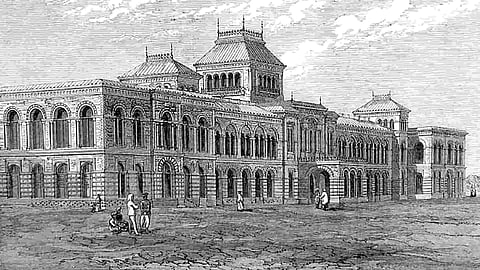

CHENNAI: This Madras College produced two Nobel laureates and took pride in having the country’s first three Bharath Ratnas. Despite this, they failed to be in the honour boards of any sort on campus for their achievements. Instead, the only statue on campus is that of a professor, who taught Tamil there.
The Presidency College on Beach Road is south India’s oldest surviving college. It has been in existence for 183 years. It was one of two British-established presidency colleges in India, the other being in Calcutta.
When the new governor, Lord Elphinstone, arrived in Madras in 1838, he declared that his government’s objective was to improve the Indians’ knowledge and awareness of European languages and sciences.
Led by advocate Norton, a delegation met the new governor with a plea signed by 70,000 people asking for new educational institutions. “We realise the real foundation of the land’s prosperity is its education,” they pleaded.
Elphinstone proposed a university within a strict time frame but immediately agreed for a school which would prepare students for collegiate education.
In 1840, the Presidency College started as a school in a rented building in Egmore, (where the head magistrate court is now) the governor inaugurated the school and spoke to the 67 students. “What you see today is not the opening of a school. You are witnesses to the dawn of a new chapter,” truer words had never been spoken on a stage. That Madras and the lands that were under its presidency it headed being known throughout the world for knowledge-based potency started that day. Later, the school was changed to black town on Broadway. There it became a high school and then a college. It was affiliated to the newly formed the Madras University.
The government decided that the first college in the presidency should have a locale and design suiting its prominence. In an innovative move the government opened an architecture competition perhaps one of the first in the world offering a prize of Rs 3,000 then a princely amount to the architect who designed the presidency college building on a sea facing site.
With this move, the government indicated its intention to turn madras into a canvas for architectural creativity thereafter 17 architects participated. One was clearly the best. That of Robert Chisholm a Scotsman working in Bengal PWD and posted in Puri. The government immediately transferred him and made him the chief architect of Madras. He was very close to the governor of Madras, named Napier.
Luckily for the city, Robert would stay in Madras for long enough to impose his indo-Saracenic style on its city scape. So influential was this design that Lutyens would use it as the mainstay while designing modern India’s new capital new Delhi. Robert hadn’t fully perfected his indo Saracenic style and a lot of Italianate element are seen in the presidency college.
The Presidency has been a witness to many changes. The site was opposite the narrow strip of sand which would later become the marina beach. The Buckingham can would be excavated on its backyard a decade after the college was built.
Three Nawabi burial graves were on the site but Chisholm built his main building well away and the sites are still revered today.
Local artisans and materiel were used for the construction, perhaps the first colonial building to be built with indigenous inputs. Granite stones were mined in St. Thomas mount and carted here. Bricks from Sulai Medu (Choolaimedu now) were brought by boat along the Cooum. The chunam mortar was ground on the site itself with shells picked on the beach. The pillars were carved at the Egmore College of Arts.
Chisholm planned classroom with plenty of sunlight and sea breeze. The domes were added to celebrate the golden jubilee. For the golden jubilee the clock designed by a science lab attender was added.
In 1870, the duke of Edinburgh opened the college. Not only were the buildings world class but the best teachers educated the lucky students.
The Marina cricket ground which is a road across from the college on its southern side is technically its playground. But many a time the college wanted to build additions classrooms on it thus wrecking the ground. It was due to the effort of PR Subramaniam, the physical education director that the ground was saved. Subbu, as he was fondly called just walked into the governor’s room and said, “Unfortunately we cannot have the European versus Indian cricket match this year”
The governor, who was the chief patron of the annual game was flabbergasted and asked Subbu the reason behind it, whose reply made the governor pass an immediate order restraining the college from constructing buildings.
During the quit India movement, the Congress leaders had been jailed. Other parties were mainly pro-British and restrained from participating. The students of the presidency college led the madras share of the quit India movement earning much thanks for it.